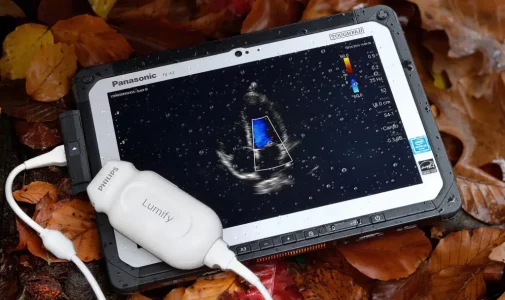
In the contemporary medical landscape, technology is playing a pivotal role. In fact, it is transforming mobile devices into powerful diagnostic tools. Additionally, mobile ultrasound apps such as Butterfly iQ, Philips Lumify, Clarius, Sonon, Mobisante MobiUS, GE Vscan, and Lumify L12-4 are revolutionizing the way imaging exams are performed. performed. These applications represent some of the most impressive innovations, indicating a significant shift in the diagnostic approach in medicine today.
How do Ultrasound Mobile Apps Work?
- Butterfly iQ: The Butterfly iQ app allows doctors to perform ultrasound exams using a portable transducer that connects to their smartphone. It offers a wide range of clinical applications and has an easy-to-use interface.
- Philips Lumify: Philips Lumify turns your smartphone or tablet into a portable ultrasound system. It works with interchangeable transducer probes, providing flexibility and convenience.
- Clarius: Clarius is an ultrasound app that uses wireless transducer technology to connect to your smartphone or tablet. It offers excellent image quality and is water resistant, making it suitable for a variety of clinical environments.
- Sonon: Sonon is an ultrasound app that works with a wireless transducer device that connects to your smartphone. Its design aims for ease of use and it offers a wide range of functionality for different medical applications.
- Mobisante MobiUS: Mobisante MobiUS is an ultrasound application that uses a transducer that connects to your smartphone. It offers advanced imaging capabilities and is designed for use in mobile environments.
- GE Vscan: GE Vscan is an ultrasound app that uses a handheld transducer device that connects to your smartphone. It offers excellent image quality and is intended for a variety of clinical applications.
- Lumify L12-4: Lumify L12-4 is an ultrasound app that works with a transducer that connects to your smartphone or tablet. It delivers high-resolution images, and designers designed it for use in a variety of clinical settings.
Impact on Medical Practice
The emergence of these apps is transforming medical practice in many ways. In addition to providing faster, more accurate and more accessible diagnoses in a variety of clinical settings, they have the potential to significantly improve the quality of healthcare and save lives around the world. Therefore, it is essential to address ethical and regulatory issues to ensure that these technological advances are used responsibly and safely.
Conclusion
Ultrasound apps, such as Butterfly iQ, Philips Lumify, Clarius, Sonon, Mobisante MobiUS, GE Vscan and Lumify L12-4, represent a revolution in medicine by allowing doctors and healthcare professionals to perform imaging exams with their smartphones. Additionally, each of these applications offers a unique approach to performing ultrasound, from connecting portable transducers to using wireless technology.
With the ability to perform ultrasound exams anywhere and at any time, these apps offer a number of benefits. Firstly, portability and accessibility stand out, allowing professionals to carry out exams even in remote locations or in emergencies. Furthermore, their ease of use and constant updates make them versatile and always up-to-date tools.
They are transforming medical practice by providing faster, more accurate and cost-effective diagnoses in a variety of clinical settings. In this way, the integration of these applications into the medical routine not only speeds up procedures, but also significantly improves the quality of healthcare offered to patients.
However, it is important to address ethical and regulatory issues to ensure that these technological advances are used responsibly and safely. With proper training and supervision, mobile ultrasound apps have the potential to significantly improve the quality of healthcare and contribute to the advancement of public health around the world.
